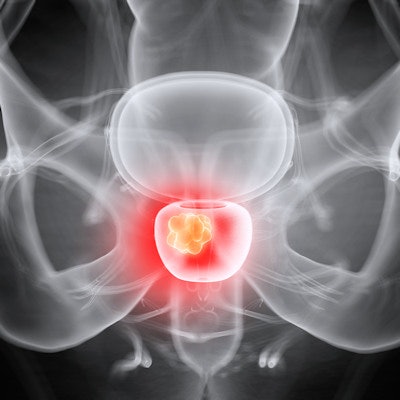
The Prostate Imaging Reporting and Data System (PI-RADS) might not be the perfect tool when it comes to using MRI to confirm suspected cases of prostate cancer, according to a study published April 21 in Radiology.
Researchers spearheading a multicenter international study of more than 3,400 male patients found that a PI-RADS score of 3 or 4 achieved positive predictive values (PPV) of only 35% and 49%, respectively, with a range between 27% and 65%.
"PI-RADS must be reliable to guide the diagnostic process, assist with management decisions, and improve patient outcomes," wrote the authors, led by Dr. Antonio Westphalen, PhD, from the University of California, San Francisco. "Therefore, the wide variability in PPV could hinder managing physician confidence in the system, affecting the broader acceptance and use of PI-RADS."
PI-RADS was developed to help clinicians and oncologists to standardize and more efficiently analyze MR images to detect prostate cancer and the severity of the disease. Previous single-center studies, however, have questioned the reliability of PI-RADS and whether the approach can be used effectively by smaller imaging centers, compared with larger facilities that have more experienced personnel.
"Nonetheless, the extent of variability in the diagnostic performance of prostate MRI remains incompletely investigated," Westphalen and colleagues added. "Such knowledge would be useful to not only better understand the expected performance of prostate MRI across practice settings but also to guide the establishment of minimum performance benchmarks and implementation of quality improvement initiatives at individual centers."
To better gauge the efficacy of PI-RADS, the researchers measured the positive predictive value of radiologists who used the tool in a retrospective study that included 3,449 men (mean age, 65 ± 8 years) with suspected or biopsy-proven untreated prostate cancer at 26 centers in the U.S. (21 facilities), Canada (2), Brazil (1), the Netherlands (1), and South Korea (1). Prostate MR imaging was performed at 1.5-tesla (451 patients, 13.1%) or 3-tesla (2,981 patients, 86.4%); magnet strength was unavailable in 17 cases (0.5%).
MRI discovered a total of 5,082 lesions. The majority of patients were rated as PI-RADS 4, followed by PI-RADS 3. The researchers found overall low PPV results with a PI-RADS score greater than or equal to 2, 3, and 4, with PPV ranging from 27% to 65%.
| Positive predictive value (PPV) of interpretations using PI‑RADS | |||
| PI-RADS ≥ 2 | PI-RADS ≥ 3 | PI-RADS ≥ 4 | |
| No. of cases | 614 (13%) | 1,490 (29%) | 2,087 (41%) |
| PPV | 31% | 35% | 49% |
| Range | 27% - 44% | 27% - 48% | 34% - 65% |
One key concern is that the wide variation in PPV results might "create particular challenges" with understanding the clinical significance of their results, Westphalen and colleagues speculated. "Wide variation in outcomes may also hinder the ability to assess radiologist or institutional performances in PI-RADS according to benchmarks, in turn potentially reducing payers' and other policymakers' support of prostate MRI."
In the meantime, they hope the findings "will motivate discussion and will lead to further research, educational initiatives, quality assurance efforts, and, perhaps, PI-RADS updates that may address this issue."



.fFmgij6Hin.png?auto=compress%2Cformat&fit=crop&h=100&q=70&w=100)




.fFmgij6Hin.png?auto=compress%2Cformat&fit=crop&h=167&q=70&w=250)











